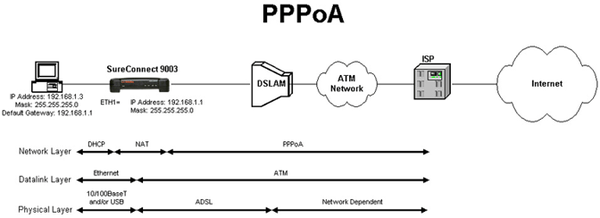The Point-to-Point Protocol over ATM (PPPoA) is a network protocol for encapsulating PPP frames in AAL5. It is used mainly with DOCSIS and DSL carriers.
It offers standard PPP features such as authentication, encryption, and compression. If it is used as the connection encapsulation method on an ATM based network it can reduce overhead slightly (around 0.58%) in comparison to PPPoE. It also avoids the issues that PPPoE suffers from, related to having a MTU lower than that of standard Ethernet transmission protocols. It also supports (as does PPPoE) the encapsulation types: VC-MUX and LLC based.
Point-to-Point Protocol over Asynchronous Transfer Mode (PPPoA) is specified by The Internet Engineering Task Force (IETF) in RFC 2364.
The use of PPPoA over PPPoE is not geographically significant; rather, it varies by the provider's preference.
Configuration
Configuration of a PPPoA requires PPP configuration and ATM configuration. These data are generally stored in a cable modem or DSL modem, and may or may not be visible to - or configurable by - an end-user.
PPP configuration generally includes: user credentials, user name and password, and is unique to each user.
ATM configuration includes:
- Virtual Channel Link (VCL) – Virtual Path Identifier & Virtual Channel Identifier (VPI/VCI), such as 0/32 (analogous to a phone number)
- Modulation (Type): such as G.dmt
- Multiplexing (Method): such as VC-MUX or LLC
ATM configuration can either be performed manually, or it may be hard-coded (or pre-set) into the firmware of a DSL modem provided by the user's ISP. It can not be automatically negotiated.

